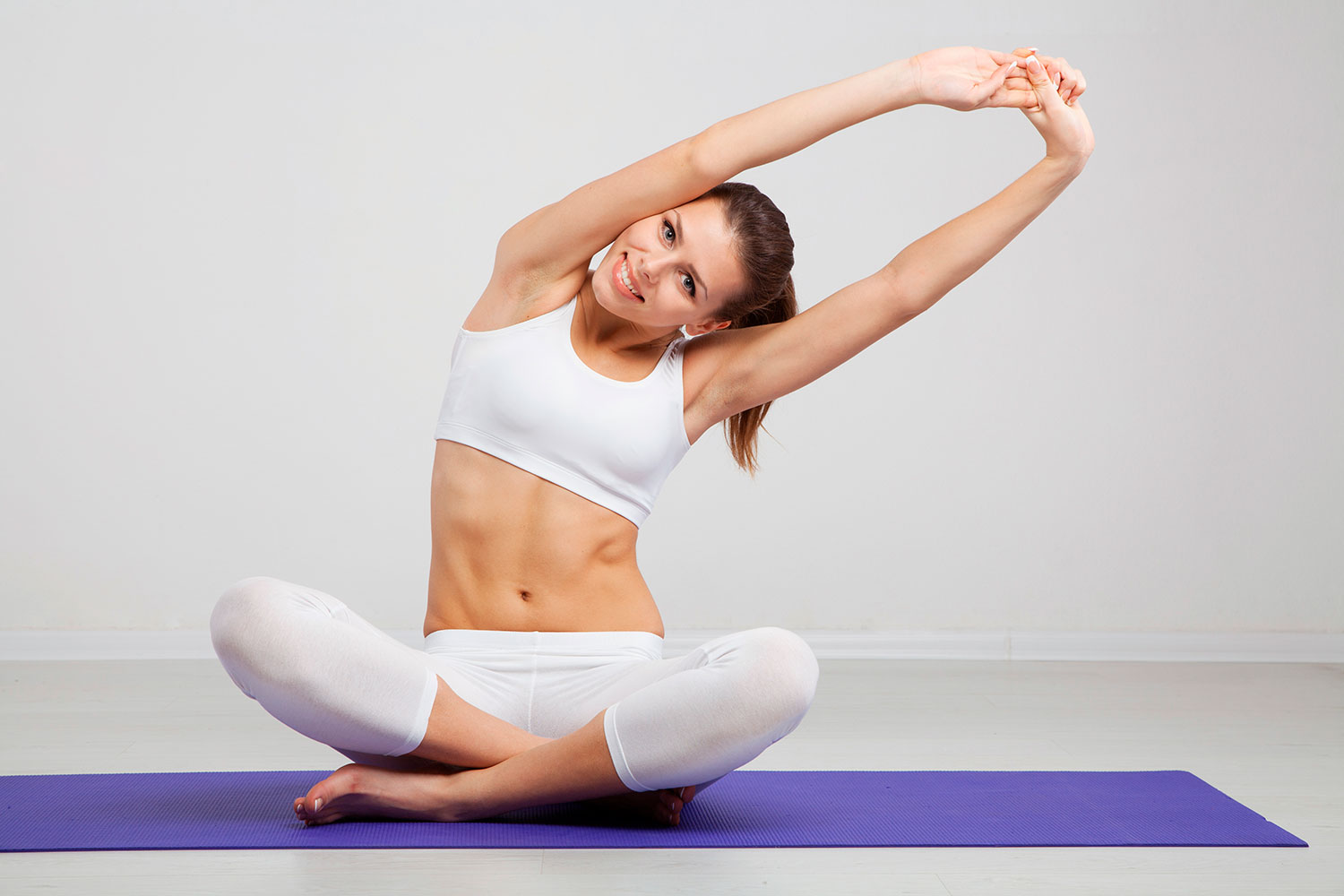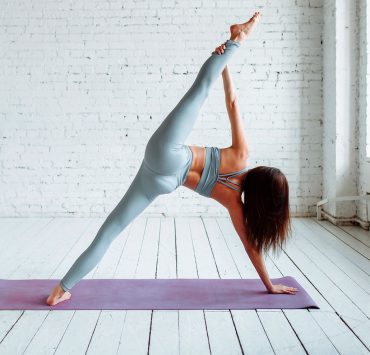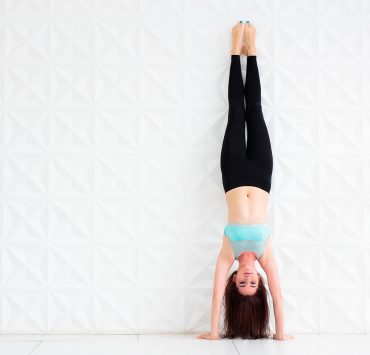
Having been a teacher’s assistant at over 50 yoga teacher…
Here’s how a regular yoga practice can heighten your awareness to your own body to promote your healthy body and healthy mind.
Yoga has grown in popularity in the western world for its benefits in strength, flexibility, stamina, increase in positive emotions, mental focus, stability, and much more. Weight loss being one of them. Yoga as a fitness regime has no doubt become a trend in recent years, but with weight loss as a common outcome with a regular yoga practice, it is due to more than yoga being a “workout.”
A recent study examined the relationship of yoga and weight loss, it showed that it was much more than the physical piece of yoga that helped with weight loss. But, the also the mental piece that showed a significant correlation. This shows that when it comes to healthy weight loss it is more than just physical exertion, but also the outlook and inward awareness with oneself and becoming more mindful. There were common themes expressed by participants in this study that they felt increased with the regular yoga practice. And I think it is safe to say that most yoga practitioners would agree that it makes total sense! The themes were divided into four different subcategories that participants felt like their weight loss pertained to:
1) Shift toward healthy eating;
2) Yoga community and culture;
3) Physical changes;
4) Psychological changes.
Shift toward healthy eating:
— Mindful eating
— Changes in food choices
— Decreased emotional or stress eating
Yoga community and culture:
— Role modeling healthy behaviors
— Different than gym culture
Physical changes:
— Increased muscle tone
— Change in metabolism
— Effects of poses and practice on weight
— Other physical effects contributing to weight loss
Psychological changes:
— Shift in mindset (Health not weight)
— Spirituality
— Mindfulness and focus
— Improved mood and emotional stability
— Reduced stress
— Self-esteem and self-acceptance
A keynote in the benefits of a yoga practice is the way that it relieves stress. When there is an imbalance in the nervous system (not enough parasympathetic) then excess stress hormones are released in the body. Cortisol, being a significant one, actually signals your body to store more excess fat. This is because in this state, commonly known as fight or flight, the body is concerned with making sure it has enough stored energy for some serious fighting or flighting. Rather than actually digesting food fully and taking the nutrients it needs. A regular practice of yoga stimulates the parasympathetic nervous system, which decreases the amount of stress hormone secretion in the body.
Stress (the sympathetic nervous system response) also induces cravings and in this study it also showed that stress-induced cortisol reactivity was related to greater amounts of caloric intake. It is possible that a higher amount of cortisol also relates to a greater amount of leptin, a hormone associated with appetite. However, more research is shedding light on the ways that yoga affects hormone levels. And in this study, leptin levels were shown to decrease with a regular yoga practice. And individuals who would be considered more seasoned practitioners as they have had a regular practice for several years, showed significantly lower levels of leptin than those that did not practice yoga regularly or were new to the practice.
Cortisol does not only affect the way hormones interact with the body but also has been studied to show changes in the brain as well, discussed in this ted talk. Basically, when there are chronic levels of stress, meaning high levels of cortisol, this changes the brain over time down to the genetic level. Increasing the amount of the fear and alert response in the brain and decreasing the brains ability to handle stress levels, learn, and process information.
Of course these things all come full circle when it comes to how the body and mind responds to stress. The more stress, the higher the levels of stress hormones and how the body responds physiologically by holding onto tension and excess weight. And the higher levels of stress hormones that are present, the harder it is for the body to handle stress. So, it is important when trying to remedy this to take things slowly and have patience. To really make a difference, it is no quick fix. But, each deeper breath is a step in the right direction.
The asana practice of yoga is most beneficial when the mental, emotional, and spiritual parts are incorporated as well. There some are asanas that require more physical exertion than others, but in the each asana there is room for becoming more mindful within your body. The heightening of body awareness is a key theme found in individuals that experience healthy weight loss when practicing yoga regularly. This is likely because of the ability to feel deeper what the body actually wants, whether it is nutritionally, physically, and emotionally, etc. Yoga strengthens the mind body connection.
So, in this list are asanas that are both more physically challenging and also more restorative for more stimulation of the parasympathetic nervous system.
Sun Salutations

Although this is a collection of different asanas, sun salutations are used as a way of warming up the body, getting blood flowing, syncing the breath, and bringing focus into the practice. Sun Salutation A & B are two different sets of salutations that are from the Ashtanga practice of yoga, a challenging and fast paced set sequence. You can see examples of both salutations from many different teachers and methods; here is one demonstration from Kino Macgregor.
Downward Facing Dog

Of course this ever-famous yoga pose made this list. Downward facing dog is both a strengthening and stretching pose that brings you into connection with your own body. While pressing firmly into your palms and feet through your heels, bring your ribs in to keep from over arching in your low back, and focus on also bringing your shoulder blades away from your ears. With all of the different actions of energy, it is important to stay aware in your body and focused on your alignment.
Chatarunga

This is a powerful and strengthening pose, really of the entire body, but significantly the arms, chest, legs, and core. It takes time to gain proper strength and alignment for Chatarunga. So, it is okay to start by practicing on your knees if that is more comfortable but still challenging enough. Begin in plank position, shift slightly forward on your toes, and keep your elbows in by your ribs as you bend at the elbows, working to get your arms at about a 90-degree angle. Staying active and engaged through your core and legs will help this immensely.
Upward Facing Dog

Upward Facing dog is a strengthening backbend that typically goes in the flow with downward facing dog and chatarunga. Backbends are invigorating as the open up the front side of the body. By pressing the tops of your feet into the mat, keep your pelvis lifted off the ground as you engage your legs, core, and press into your hands to lift your chest, extending your spine and lifting the crown of your head. Stay active, and focus on not slumping into your shoulders, keeping them down your back and away from your ears.
Low Lunge

In this lunge, by keeping your back knee on the ground you are opening the front side of your extended hip, and working the stabilizing muscles on the other hip of the bent knee. The opening of your hip flexors, gives release to the psoas, the biggest hip flexor muscle that typically holds a lot more tension than we realize. Giving this muscle a break really gives your body a chance to let go stress buildup.
Warrior II

Warrior II strengthens the legs, core, and arms while simultaneously opening the hips, inner thigh, and chest. In Warrior II your front knee is bent, knee over ankle. The back leg is straight, with the back foot parallel to the short edge side of your mat and at heel-to-arch alignment with the front foot. With arms outstretched wide, stay engaged through the core, active through the arms, and shoulders (like usual) away from your ears. Staying in Warrior II will help develop concentration, grounding, and power.
Wide Leg Forward Fold

Wide legged forward folds open the hips, hamstrings, engage the core, and also stimulate and benefit the internal organs. Since you are inverting your head toward the ground, this is pose also very calming to the mind and brings fresh blood flow to the brain. Try to stay engaged in your core as you fold down with your legs wide, toes pointed slightly in, and place your hands in a comfortable position either on the ground, holding your feet, or hands clasped behind you.
Boat

Boat pose is a major core strengthener, which does wonders for the spine by strengthening the muscles that support the spine. It also improves balance, focus, and helps with stress relief by directing more attention to your body and working in the pose. Balancing on your tailbone, stay very actively engaged in your core as you life your legs off the ground actively, steaching your arms out in front you, and playing with maybe straightening the legs and working on your balance.
Malasana

Malasana is a deep squat that opens the hips, stretches the feet, hamstrings, glutes, back, and neck. It aids in digestion, metabolism, and keeping the pelvic floor and joints mobile and happy. With your feet slightly wider than your hips, toes pointed slightly outward, bend your kees deeply to lower your hips. If needed, you can place your heels on a blanket or support if your heels want to lift off the ground. Using your hands together at heart center, use your elbows to press into the inside of your knees and encourage further opening.
Bridge

Bridge pose is a glute and hamstring strengthener while opening the front body in a backbend. This backbend is also helpful in psoas release, stimulates the organs of the back, and helps with low back pain. Press firmly though your heels with your knees bent to lift your hips up. Stay pressing through your heels, and engaged through your core to lift higher, and continue to encourage your shoulder blades coming in toward each other and down your back.
Wheel

Wheel pose, also known as Upward Facing Bow, is a deep backbend that tones muscles all over your body. It helps to strengthen the wrists, legs, core, back, shoulders, arms, and opens up the entire front side of the body. Backbends are revitalizing to the body as they stimulate internal organs, promote blood circulation, and also importantly open up and move the spine in a way that it often doesn’t do (especially with the common sedentary lifestyle we lead by driving and working at a desk). From bridge pose, press your hands into the mat by your ears, with your fingers toward your shoulders, and engage through your arms and legs to press yourself up. Try to straighten your arms, stay actively pressing into the mat with your feet and engaged at your naval.
Spinal Twist Reclined

This is one that I personally always have in my own practice. Spinal twists, especially reclined, are one of the few ways that allows the spine to decompress in a way that creates space for the intervertebral discs to take a breather and release tension. Spending several minutes each way in this twist release tension, signals to the parasympathetic nervous system response to calm, balances the autonomic nervous system, and much more. Take the time breathe deeply and slowly as your legs fall to one side, with your arms outstretched, and turning your head over the opposite shoulder to complete the twist.
Child’s Pose

Child’s pose brings you into a space like home. This asana is wonderful for calming the mind, decompressing and stabilizing the spine, gently opening the low back and hips, and massaging internal organs. In this pose you can come into deep connection with your breath and bringing more internal awareness of your body and state of being. With your hips sitting back towards your heels, your chest and head coming towards the ground, and your torso melting over your knees either together or wide, you can get comfortable with your arms outstretched or down by your sides.
Tree

Tree pose is a balancing posture that brings balance to the mind by improving focus, concentration, and more awareness into your body. By bringing your weight onto one foot, slowly place the other foot on your inner calf or thigh and practice the balance. Your arms can outstretch overhead or be placed at heart center. The key for maintaining balance is to set your gaze on a fixed non-moving point, known as a drishti.
Shoulder Stand

Shoulder stand, when done properly, is an inversion that brings strengthening, stabilization, and balance to the body. With your shoulders as the foundation for the pose, it is important that your neck is not on the mat for safety, and the body then lifts and stacks on top of the shoulders supported by the hands on the back. Inversions reverse the blood flow in the body, improving circulation and metabolism, and this particular inversion also stimulates the parasympathetic nervous system to release stress buildup.
With a yoga practice, it is also important to incorporate pranayama (breathing practice) and meditation. With asana, these three create a full practice that stimulates and benefits your physical body, emotional body, mind, and spirit. And, keep your practice regular! The balancing of the nervous system, strengthening, opening, calming, focusing, and all of the other benefits that comes from a yoga practice stay with a regular practice. You can’t take one class and be good to go. It is a daily practice of learning, growing, and being in the practice where the results come from.
Yoga is a practice that exists to deepen the connection to the self, the mind body connection, self-awareness, self love, and self growth. This is done with yoga asana, meditation, and pranayama. Yoga is much more than just a physical practice; it is mental, emotional, and spiritual as well. The asanas themselves do create more space with flexibility, circulate blood, strengthen the body, and increase more body awareness. Which does also beneficially affect the mind and outlooks in all aspects of life. This is where a healthy lifestyle really thrives, when it is about how you feel in all ways, more than just physically. This is important to remember in a society full of yoga fitness with the focus on the body. The mentality, emotional health, environment, physical body, awareness, and spirituality all comes full circle to interact and affect each other. After all, a healthy and a healthy body are one in the same!
What's Your Reaction?
Having been a teacher’s assistant at over 50 yoga teacher trainings worldwide, Rebecca Rebecca has a firm grasp on the fine art of yoga and meditation. In her work, she carefully reflects on a vast expanse of knowledge to help others find peace in both body and mind.















Hello! An individual around my Myspace party contributed this excellent website with us so i located offer that a new seem. I’m definitely experiencing the knowledge. I’m bookmarking and will also be tweeting this specific to be able to my own supporters! Fantastic blog site along with remarkable styling.
I quite like everything you folks tend to be in place too. This type of ingenious do the job as well as insurance! Carry on the great functions guys I’ve added in anyone people to be able to the blogroll.
I merely wished to write down a quick concept so that you can say thanks to a person for those wonderful ideas and also hints you happen to be demonstrating on this web site.